OUTLINE LESSONS 11a and 11b
Price and Output Determination: Monopolistic Competition &
Oligopoly
11a - MONOPOLISTIC COMPETITION
|
I. Introduction: The Product Markets
A. Circular
Flow Model
B. Four Product Market Models
1. Competitive
Market (Lessons 8/9a, 8/9b)
2. Monopoly
(Lessons 10a, 10b)
3. Monopolistic
Competition (Lesson 11a)
4. Oligopoly
(Lesson 11b)
C. General Outline for Each Model
1. Characteristics and Examples
2. Nature of the Demand Curve
3. Short Run Equilibrium (Profit Max.)
4. Long Run Equilibrium and Efficiency
5. Other Issues
II. Definition: Monopolistic Competition
A market structure in which
many firms sell a differentiated product into which entry is
relatively easy in which the firm has some control over its
product price and in which there is considerable nonprice
competition.
III. Characteristics
A. NUMBER OF FIRMS: many
Therefore:
1. Small market share (Small concentration ratio)
2. No collusion possible
A situation in which
firms act together and in agreement (collude) to fix prices
divide a market or otherwise restrict competition.
3. Independent action (no mutual interdependence)
B. TYPE OF PRODUCT: differentiated
1. Definition: A
strategy in which one firm’s product is distinguished from
competing products by means of its design, related services,
quality, location, or other attributes (except
price).
2. also called nonprice
competition
distinguishing
one’s product by means of product differentiation and
then advertising the distinguished product to
consumers.
3. How?
a) product quality
b) services
c) location
d) brand names and packaging
4. Effect of product differentiation: some control over
price
5. Cost of product differentiation: need to
advertise
C. CONTROL OVER PRICE:
1. within narrow limits
2. little econ. power
D. EASE OF ENTRY: relatively easy entry
E. NONPRICE COMPETITION: very much
IV. Examples
A. Concentration Ratio - low
The percentage of the
total sales of an industry made by the four (or some other
number) largest sellers in the industry.
B. Herfindahl Index - low
A measure of the
concentration and competitiveness of an industry; calculated as
the sum of the squared percentage market shares of the
individual firms.
SUM % market shares
squared
If monopoly = 100
squared = 10,000
If 4 firms with 25% each =
= 25 squared + 25
squared + 25 squared + 25 squared
= 2500
if 100 firms with 1% each =
= SUM 1 squared + 1
squared + . . . . .
= 100
C. Examples
Percentage of Output Produced by Firms in Selected
Low Concentration U.S. Manufacturing Industries
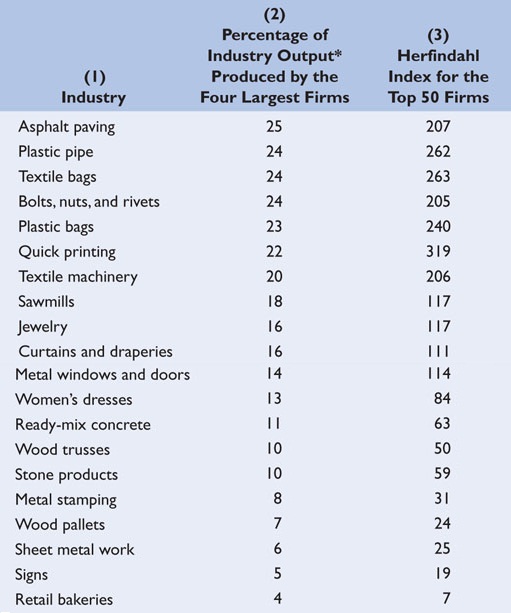
ALSO:
retail
establishments in metropolitan areas, such as
grocery stores
gas stations
barber shops
dry cleaners
clothing stores
restaurants
V. Price and Output Determination
A. Benefit-Cost Analysis - Review 2 Steps
1. find Q where MR=MC
2. produce Q only if AR>AVC
B. Demand and Monopolistic Competition
1. downsloping
2. quite price elastic - WHY?
C. Three Short Run Cases
1. profit maximizing economic profits
[graph]
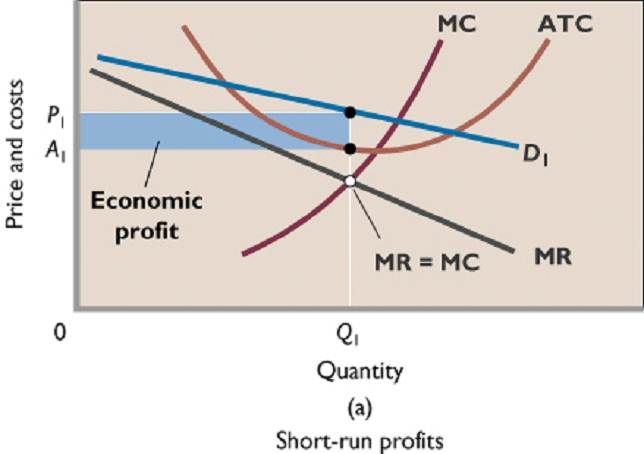
2. loss minimizing (graphs)
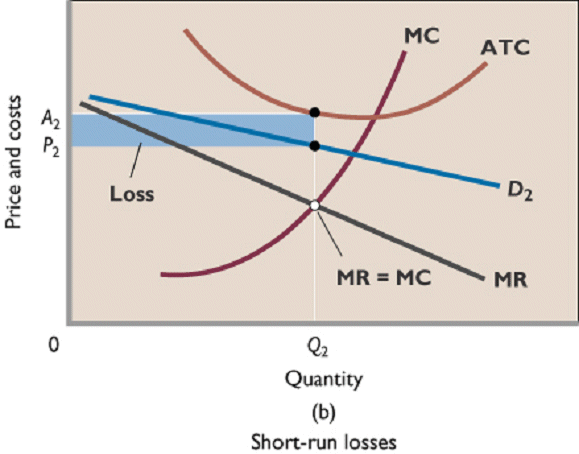
3. shut down
D. Long Run Equilibrium
1. Few barriers to entry
2. Therefore, tends toward normal profits
a. if profits: firms enter

b. if losses: firms leave

c. Result: Normal Profits
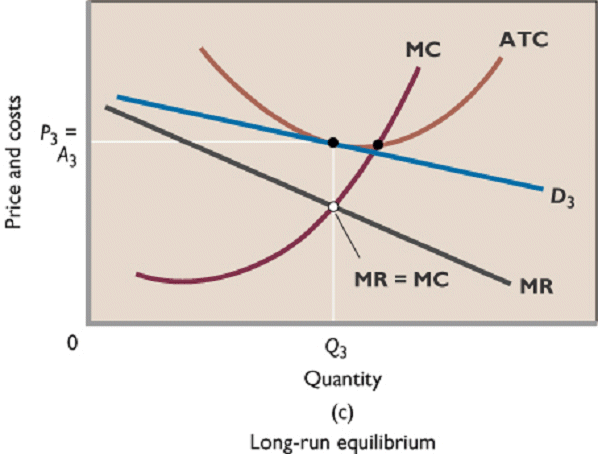
d. but there are complications:
(1) Some firms may achieve a measure of
differentiation that is not easily duplicated by rivals
(brand names, location, etc.) and can realize economic
profits in the long run.
(2) There is some restriction to entry, such as
financial barriers that exist for new small businesses,
so economic profits may persist for existing firms.
(3) Long-run below-normal profits may persist, because
producers like to maintain their way of life as
entrepreneurs despite the low economic returns.
3. Long Run Equilibrium:
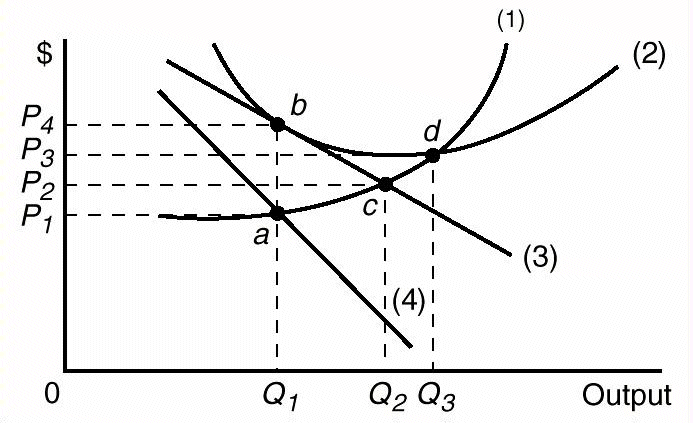
a. profit maximizing quantity (MR=MC) is Q1
b. profit maximizing price is P4

a. profit maximizing quantity (MR=MC)
is Q3
b. profit maximizing price is P3
VI. Monopolistic Competition and Efficiency
A. Allocative Inefficiency
1. At the profit maximizing quantity P>MC
a) underallocation of resources:
b) but close with elastic demand
c) also, some utility gained from product
differentiation
2. only normal profits
3. see graph below

a. the allocative efficient quantity is: Q2 = WHAT WE
WANT
b. the profit maximizing quantity is Q1 = WHAT WE
GET
B. Productive Inefficiency
1. not minimum ATC (not where MC=ATC)
2. excess capacity
Plant resources which
are underused when imperfectly competitive firms produce
less output than that associated with achieving minimum
average total cost.
3. also, advertising may increase costs without
increasing utility (graph)
4. see graph below

the productively efficient quantity is Q3
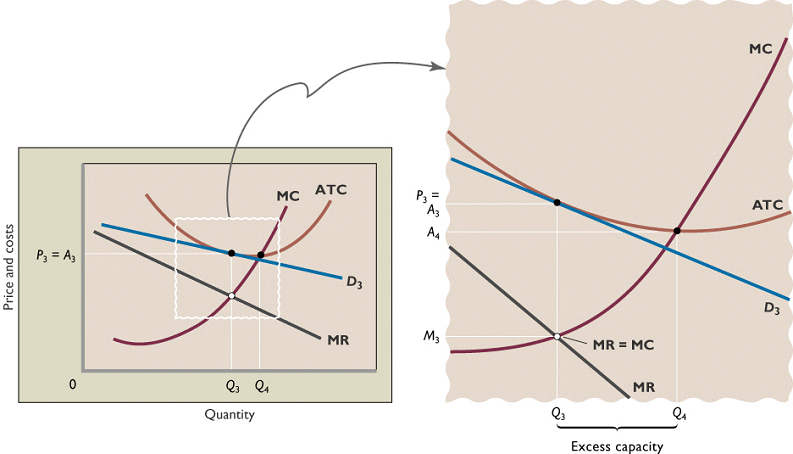
I. Introduction: Four Product Market Models
A. Competitive Market (Lessons 8/9a, 8/9b)
B. Monopoly (Lessons 10a, 10b)
C. Monopolistic Competition (Lesson 11a)
D. Oligopoly (Lesson 11b)
II. Definition - Oligopoly
A market structure in which
a few firms sell either a standardized or differentiated product
into which entry is difficult in which the firm has limited
control over product price because of mutual interdependence
(except when there is collusion among firms) and in which there is
typically nonprice competition.
III. Characteristics - Oligopoly
A. NUMBER OF FIRMS: few
1. mutual interdependence
A situation in which a
change in price strategy (or in some other strategy) by one
firm will affect the sales and profits of another firm (or
other firms); any firm which makes such a change can expect
the other rivals to react to the change.
2. collusion possible
A situation in which
firms act together and in agreement (collude) to fix prices
divide a market or otherwise restrict competition.
B. TYPE OF PRODUCT:
homogenous OR differentiated
homogeneous
oligopoly - An oligopoly in which the firms produce a
standardized product.
differentiated oligopoly
- An oligopoly in which the firms produce a differentiated
product.
C. CONTROL OVER PRICE:
1. much if there is collusion
2. limited by mutual interdependence
A situation in which a
change in price strategy (or in some other strategy) by one
firm will affect the sales and profits of another firm (or
other firms);
any firm which makes such a
change can expect the other rivals to react to the
change.
D. EASE OF ENTRY: significant obstacles or barriers to entry
(from lesson 10a)
1. economies of scale: costs
a) graphically
b) rationale
c) natural monopolies
3. legal barriers
a) patents
b) licenses
3. ownership of essential raw materials
4. pricing and other strategic barriers
E. NONPRICE COMPETITION: much with differentiated
products
IV. Examples
Percentage of Output Produced by Firms in Selected
High Concentration U.S. Manufacturing Industries
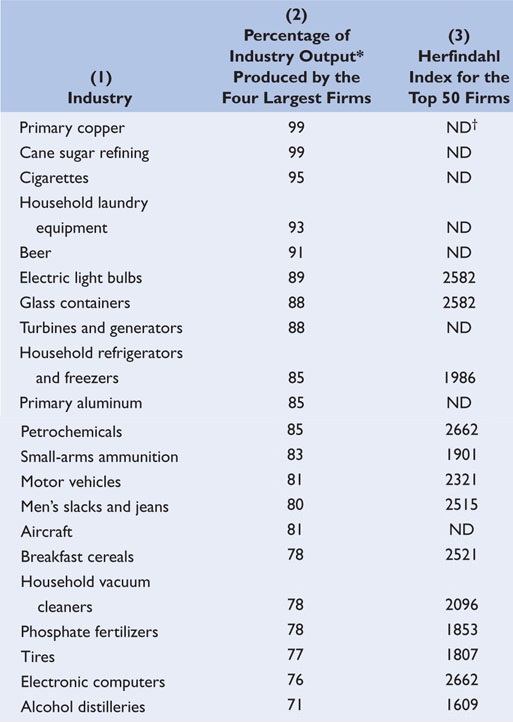
Also:
U.S Aluminum Industry
Auto Parts in Medium-size towns
"Big 4", "Big 3", etc.
V. Measures of Industry Concentration
A. Concentration
ratio
The four-firm concentration ratio gives the percentage
of total industry sales accounted for by the four largest firms
B. The concentration ratio has several shortcomings in terms
of measuring competitiveness.
1. Some markets are local rather than national, and a
few firms may dominate within the regional market.
2. Interindustry competition sometimes exists, so dominance
in one industry may not mean that competition from substitutes
is lacking.
3. World trade has increased competition, despite high
domestic concentration ratios in some industries like the auto
industry.
4. Concentration ratios fail to measure accurately the
distribution of power among the leading firms.
5. Concentration tells us nothing about the actual market
performance of various industries in terms of how vigorous the
actual competition is among existing rivals.
C. The Herfindahl index
- A measure of the concentration
and competitiveness of an industry or another way to measure
market dominance.
- calculated as the sum of the
squared percentage market shares of the individual firms.
- so that much larger weight is given to firms with high
market shares.
- A high Herfindahl index number indicates a high degree
of concentration in one or two firms.
- A high index might be where one firm has 80 percent of
the industry and the others have 6 percent each for a total
of 6400 + (6 squared x 3) = 6,508.
- A lower index might mean that the top four firms have
rather equal shares of the market, for example, 25 percent
each (25 squared x 4 = 2,500).
VI. Oligopoly Behavior: A Game-Theory Overview
A. Game theory
B. Mututal Interdependence Revisited
C. Collusion
D. Incentive to cheat
VII. Price and Output Determination
A. No Standard Model But Common Pricing
Characteristics
1. Why no common model
a) diversity of specific market situations
b) collusion possible
A situation in
which firms act together and in agreement (collude) to
fix prices divide a market or otherwise restrict
competition.
c) mutual interdependence
A strategy in which
one firm’s product is distinguished from competing
products by means of its design, related services,
quality, location, or other attributes (except
price).
2. Common pricing characteristics
a) prices tend to be inflexible
b) when prices do change, firms tend to change prices
together
B. Three Oligopoly Pricing Models
1. kinked demand: noncollusive oligopoly
2. collusion
3. price leadership
C. Kinked Demand: Noncollusive Oligopoly
1. Kinked Demand Curve
IMPORTANT: based on
the assumption that rivals will:
- follow a price
decrease, and
- ignore a price
increase.
2. demand and MR curve
a. if competitors IGNORE price increases
A firm will expect demand will be elastic
(flatter) when it increases price.
From the total-revenue test, we know raising prices
when demand is elastic will decrease revenue.
So the noncolluding firm will not want to raise
prices.
b. if competitors MATCH price decreases
The individual firms believe that rivals will
match any price cuts.
Therefore, each firm views its demand as inelastic
(steeper) for price cuts,
which means they will not want to lower prices since
total revenue falls when demand is inelastic and prices
are lowered.
c. result:
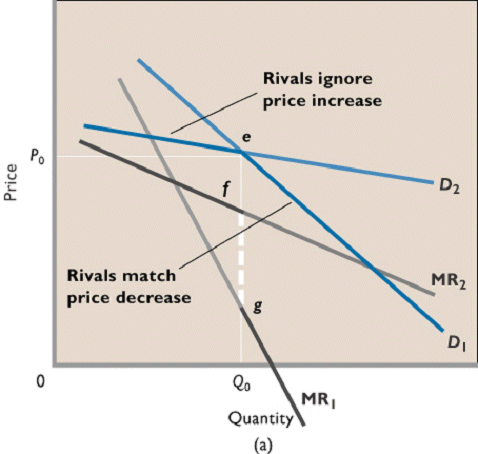
d. textbook
graph
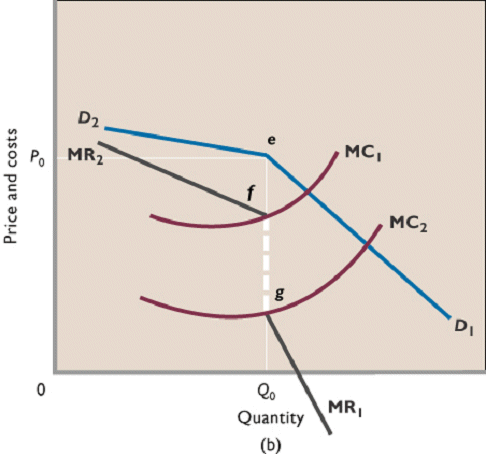
e. lecture graph
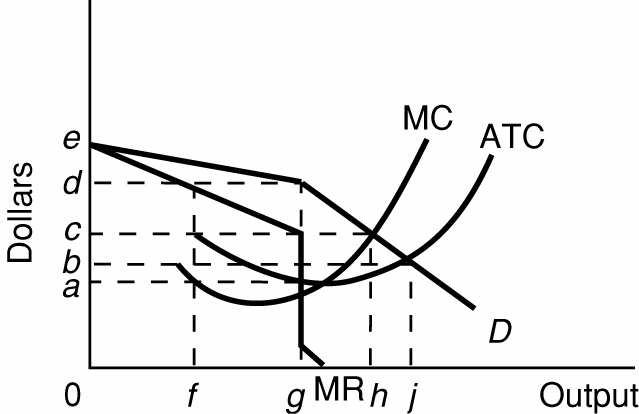
3. price and output determination (see graph
above)
a. profit maximizing quantity: 0g
b. profit maximizing price: 0d
|

|

|
4. price inflexibility
a. This analysis shows how prices tend to be
inflexible in oligopolistic industries.
b. The figure above shows that marginal cost has
substantial ability to increase at price P before it no
longer equals MR; thus, changes in marginal cost will also
not tend to affect price.

5. criticisms
a. There is no explanation of why P is the original
price.
b. In the real world oligopoly prices are often not
rigid, especially in the upward direction.
6. Quick
Quiz
7. Examples ?
8. optional: The
Kinked Demand Model
D. Cartels and Other Collusion
Cartels and collusion agreements constitute another oligopoly
model
1. definition collusion
2. examples
OPEC Cartel
Cartel: A
formal agreement among firms in an industry to set the
price of a product and the outputs of the individual
firms or to divide the market for the product
geographically.
3. price and output determination
a. assumptions
b. joint profit maximization
c. graph
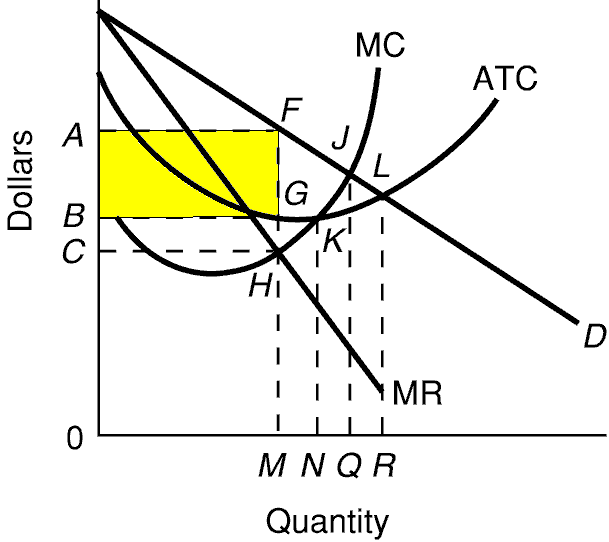
To maximize profits, the firms collude and agree to a
certain price. Assuming the firms have identical cost,
demand, and marginal-revenue date the result of collusion is
as if the firms made up a single monopoly firm.
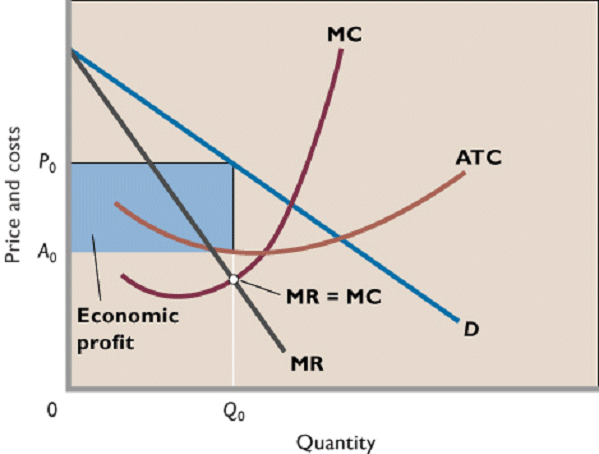
4. overt collusion: the OPEC cartels
A cartel is a group of producers that creates a
formal written agreement specifying how much each member
will produce and charge.
The Organization of Petroleum Exporting Countries (OPEC)
is the most significant international cartel.
map
5. covert collusion - tacit understanding
Cartels are illegal in the U.S., so any collusion
here is secret, or covert.
When firms
reach verbal understandings with one another on product
price - frequently through interaction on golf courses,
cocktail parties, via phone, or at trade association
meetings.
Historically,
these understandings are referred to as Gentlemen's
Agreements.
Tacit
understandings are in violation of antitrust laws, but their
elusive nature makes them difficult to detect.
Examples of these illegal, covert agreements include:
- the 1993 collusion between dairy companies
convicted of rigging bids for milk products sold to
schools
-in 1996, American agribusiness Archer Daniels
Midland, three Japanese firms, and a South Korean firm
were found to have conspired to fix the worldwide price
and sales volume of a livestock feed additive.
- electrical equipment conspiracy
- ND highway contractors
6. obstacles to collusion
a. Differing demand and cost conditions among firms
in the industry;
b. A large number of firms in the industry;
c. The temptation to cheat;
d. Recession and declining demand;
e. The attraction of potential entry of new firms if
prices are too high; and
f. Antitrust laws that prohibit collusion.
E. Price Leadership
1. definition
An
informal method which firms in an oligopoly may employ to
set the price of their product: one firm (the leader) is the
first to announce a change in price and the other firms (the
followers) soon announce identical or similar
changes.
2. Price leadership in oligopoly occasionally breaks down
and sometimes results in a price war.
A recent example occurred in the breakfast cereal
industry in which Kellogg had been the traditional price
leader.
3. Examples - current or recent
Farm Machinery
Cement
Copper
Newsprint
Glass Containers
Beer,
Fertilizer
Cigarettes
VII. Oligopoly and Efficiency
A. Allocative and Productive
Efficiency
Allocative and productive efficiency are not realized
because price will exceed marginal cost and, therefore, output
will be less than minimum average-cost output level
1. Kinked Demand

a. profit maximizing quantity:
0g
(where MR = MC, "what we get')
b. allocatively efficient quantity: 0h
(where P = MC, "what we want')
c. productively efficient quantity:
minimum ATC
2. Collusion

a. profit maximizing quantity:
0M
(where MR = MC, "what we get')
b. allocatively efficient quantity: 0Q
(where P = MC, "what we want')
c. productively efficient quantity: 0N
(minimum ATC)
3. The economic inefficiency may be lessened
because:
a. Foreign competition can make oligopolistic
industries more competitive (efficient) on a global
scale.
b. Oligopolistic firms may keep prices lower (and
more efficient) in the short run to deter entry of new
firms.
c. Over time, oligopolistic industries may foster
more rapid product development and greater improvement of
production techniques than would be possible if they were
purely competitive.
called Dynamic Efficiency
- they have the means = long run
profits
- they have an incentive - barriers to entry
protect profits
VIII. Oligopoly and Advertising
A. Product development and advertising campaigns are
more difficult to combat and match than lower prices.
B. Oligopolists have substantial financial resources with
which to support advertising and product development.
C. Advertising can affect prices, competition, and
efficiency both positively and negatively.
1. Advertising reduces a buyers’ search time
and minimizes these costs. - GOOD
2. By providing information about competing goods,
advertising diminishes monopoly power, resulting in greater
economic efficiency. - GOOD
3. By facilitating the introduction of new products,
advertising speeds up technological progress. - GOOD
4. If advertising is successful in boosting demand,
increased output may reduce long run average total cost,
enabling firms to enjoy economies of scale. ( from a to
b)
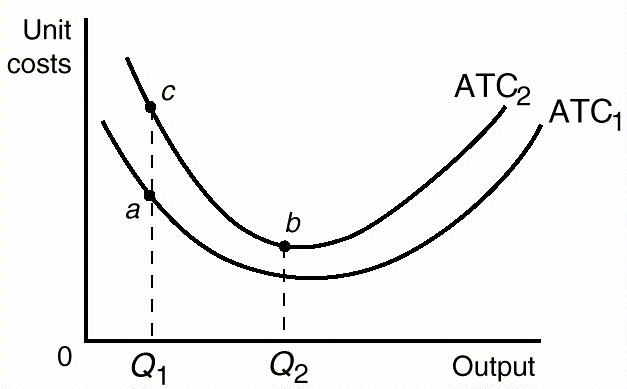
5. Not all effects of advertising are positive.
a. Much advertising is designed to manipulate
rather than inform buyers.
b. When advertising either leads to increased monopoly
power, or is self-canceling, economic inefficiency
results.












